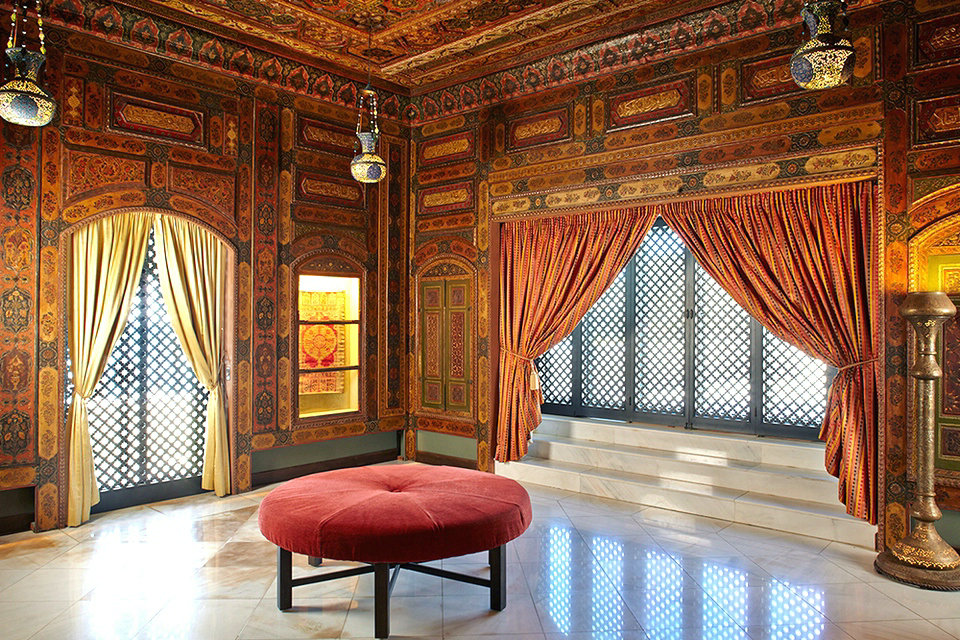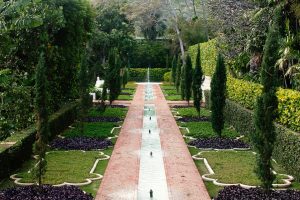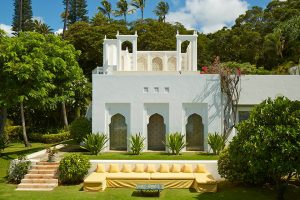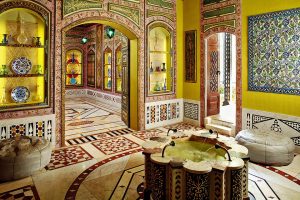The Damascus Room is a highlight of the Islamic art collection assembled by Doris Duke (1912–93) and is one of two Syrian interiors preserved at Shangri La. Its acquisition dates to 1952, when Duke placed an order for “1 Old Damascus Room made of old painted panels of wood” with Asfar & Sarkis, an antiquities firm based in both Damascus and Beirut, which she had worked with since the late 1930s. The purchased “Old Damascus Room” consisted of eighteenth-century wood paneling (four walls and a ceiling), which would have originally decorated a reception room (typically known as a qa‘a) of an affluent courtyard home in Syria. At the time, Syria was ruled by the Ottoman Turkish empire (in Syria: 1516–1918). Such rooms are therefore commonly described as late Ottoman–period Syrian interiors.
The wood paneling of the Damascus Room consists of both flat and raised painted surfaces. The latter are achieved through the ‘ajami technique, in which a paste-like mixture of animal glue and gypsum powder is applied to the wood substrate to create relief. In the Damascus Room, the raised ‘ajami surfaces, as well as the surrounding flat ones, are further embellished with metal leaf (gold, copper, tin) covered in multicolored translucent glazes (red, green, yellow, orange). These surfaces are shiny and stand in contrast to duller ones painted with pigments like smalt (blue), white lead and cochineal (pink). Gold leaf is also found on the most important surfaces, including the cartouches with beautiful calligraphy praising the Prophet Muhammad’s companions, which are located on the upper walls. The final effect is a visual play between flat and raised surfaces, and matte and glossy ones. Today, this effect is somewhat muted as much of the wood paneling has darkened due to corrosion of the metal leaf and multiple layers of varnish. Most late-Ottoman Syrian interiors, both in situ and abroad, have suffered a similar fate. It is in fact quite rare to encounter ‘ajami paneling that remains bright and colorful as originally intended.
The ‘ajami paneling purchased from Asfar & Sarkis in 1952 required considerable retrofitting to meet the dimensions of the preexisting guestroom located off Shangri La’s foyer. This retrofitting, which entailed the restoration of old panels and the creation of new ones, was done by the al-Khayyat workshop of Damascus. This workshop specialized in the creation and restoration of ‘ajami interiors and was led by the master artist Muhammad ‘Ali al-Khayyat (better known as Abu Suleyman). From the 1930s until his death in 1960, Abu Suleyman participated in the restoration and retrofitting of a number of ‘ajami interiors, including those preserved in the Robert Mouawad Private Museum in Beirut and the National Museum of Damascus. The Damascus Room at Shangri La therefore speaks to broader global trends in the preservation and appreciation of late-Ottoman Syrian interiors during the twentieth century. In this space, visitors can view exceptional eighteenth-century ‘ajami, as well as mid-twentieth-century workmanship by master Damascene artisans.
The Damascus Room opened to public tours for the first time in July, 2012. The room as it appears today is a new installation—one that enables visitors to enter the space, sit and enjoy the ‘ajami paneling, and peruse objects and textiles from the DDFIA collection.
Interiors and furnishings
The Damascus Room’s four walls and ceiling are comprised of predominantly eighteenth-century wood ‘ajami paneling of the type common to late-Ottoman Syrian interiors. This historic paneling is punctuated by five shelved vitrines for the display of precious items, four closed cupboards for the storage of household belongings, two sets of doors (one serving as the entrance, the other leading to a closet and bathroom; both sets of doors functioned as window shutters in the historic Damascene house), and two large openings leading out to a small lanai (south) and the Jali Pavilion (west). The upper walls feature cartouches enclosing exquisite gold calligraphy in praise of the Prophet Muhammad’s companions. The ceiling’s design resembles a carpet, with a central rectangular field enclosed by a series of borders. In the middle of the ceiling, an elaborate gold finial projects downwards from a large cartouche embellished with gilded wooden carvings and painted floral patterning evoking Indo-Persian textiles.
Although the Damascus Room’s ‘ajami paneling was purchased, prepared and installed between 1952 and 1955, the room’s history can be traced to 15 years earlier, when Doris Duke (1912–93) first visited Syria and was exposed to the upperclass residential architecture of the late Ottoman period. In the spring of 1938, Duke and her husband James Cromwell embarked on a six-week tour of the Middle East, which included visits to Iran, Syria and Egypt. Detailed arrangements for this trip were made by Arthur Upham Pope (1881–1969), an American dealer, collector and scholar of Persian art. Among other things, Pope provided introductions to individuals who would assist with the Cromwells’ travels and research. One such individual was the dealer Georges Asfar (d. 1995) who, along with Jean Sarkis (d. 1955), led the then Damascus-based antiquities firm of Asfar & Sarkis. As anticipated, the Cromwells encountered Asfar & Sarkis during their visits to Damascus in March and April 1938. On one occasion, Duke shopped for early-twentieth-century bureaus sheathed in mother-of-pearl within the courtyard of a late Ottoman home that was being rented by the Sarkises and was hence known as “Sarkis Palace.” According to descendants of Jean Sarkis, “Sarkis Palace” served not only as the Sarkis family home but also as a site for conducting Asfar & Sarkis business (Overton 2012). In this beautiful space, the dealers would welcome foreign clients and market their wares, including the bureaus (65.46) that Duke would soon purchase.
Originally built in the mid-nineteenth century and located on Bab Tuma Street in the Christian quarter of Damascus, “Sarkis Palace” is today more commonly known as the “House of the Spanish Crown,” for it served as the Spanish Consulate just prior to the First World War (Weber 2009). In the 1938 photograph of Duke shopping for chests, she faces the north side of the courtyard with two doors. Based on a floor plan published in 1924 by German scholars who, for one year in 1917/18, used the home as their offices, it is clear that the two doors once led into closed interiors, each with four courtyard-facing windows (Wulzinger and Watzinger 1924). The one on the left was a qa‘a of the typical configuration: lower entry area (‘ataba) and single upper seating area (tazar) (map in Wulzinger and Watzinger 1924). Most likely Duke would have entered these rooms, or others like them, during her visit to “Sarkis Palace” in 1938. This experience must have left quite an impression on the young collector, who early on exhibited an interest in historic interiors. She would wait another 15 years, however, to purchase her first Syrian interior from Asfar & Sarkis.
At the time of Duke’s visit to “Sarkis Palace” in 1938, Asfar & Sarkis were deeply involved in the preparation of late Ottoman–period Syrian interiors for sale, whether to Middle Eastern, European or American clients. They had recently sold the “Nur al-Din” interior (a qa‘a with a single tazar; now the Metropolitan Museum of Art’s “Damascus Room”) and elements from the so-called “Quwatli” courtyard house to Hagop Kevorkian (1872–1962), a dealer based in New York. The “Nur al-Din” and “Quwatli” architectural elements were shipped to the United States in 1934, just four years prior to Duke’s visit to Syria. In preparing them for sale, the dealers were assisted by Damascene craftsmen—specifically, the al-Khayyat workshop led by Muhammad ‘Ali al-Khayyat, better known as Abu Suleyman (Baumeister et al. forthcoming). In the 1930s, Abu Suleyman and his workshop restored and retrofitted a number of Damascene late-Ottoman ‘ajami interiors, for example, in Damascus’s al-ʿAzm palace (Duda 1971); in the Beirut home of Henri Pharaon (d. 1993), now known as the Robert Mouawad Private Museum (Carswell 2004; Duda 1971; Khoury 1993); and most likely the interiors today displayed at the University of Pittsburgh and in the Cincinnati Art Museum (Scharrahs 2013).
When Duke returned to Syria and Lebanon in the early 1950s, the worlds of Asfar & Sarkis, the al-Khayyat workshop, and the “House of the Spanish Crown” intersected once more. After a visit to Damascus in 1953, she placed an order with Asfar & Sarkis for “1 old Damascus Room made of old painted panels of wood,” which they had acquired in 1938 through the broker “Mohamad Khayat.” This individual was Muhammad ‘Ali al-Khayyat (Abu Suleyman), the master artisan mentioned above (Overton 2012). In the early 1950s, Abu Suleyman was in the midst of yet another major retrofitting project, the preparation of an interior from Bayt Mardam-Bey for integration into the National Museum of Damascus (Khoury 1993). This project entailed not only the preservation of the historic room but also its considerable expansion to satisfy its new home in the museum. Of equal interest to the Shangri La narrative is the fact that Abu Suleyman’s workshop had by 1953 moved into the “House of the Spanish Crown,” which Duke had visited as a 26-year-old in 1938 (the al-Khayyat workshop moved into the home shortly after the Sarkises returned to Beirut and established a new store in the St. Georges Hotel). The workshop remained active in the Bab Tuma house until quite recently (c. 2011).
The room that Asfar & Sarkis acquired through Abu Suleyman in 1938 required considerable retrofitting for its incarnation in a preexisting guestroom located off the foyer at Shangri La. Indeed, nearly a sixth of the interior’s total cost was spent on “fixing and repairs,” which were carried out by the al-Khayyat workshop. This retrofitting entailed the expansion and reduction of panels, the overpainting of surfaces, and even the creation of new wood elements, such as a red cartouche in the ceiling and long panels that are distinguished today by their lighter backgrounds. To ensure the room’s successful completion, the workshop mocked-up the room to size in Damascus, perhaps in a space within the “House of the Spanish Crown.” Over a dozen photographs of the mocked-up room were taken in Damascus in August 1954 and sent to Duke just prior to its shipment in nine cases. In these images, some of which include Georges Asfar, we can see that Asfar & Sarkis were not just selling Duke the wood perimeter of a room but also the objects and textiles that could furnish it, including hanging lamps, braziers, water pipes, small tables, and various textiles. Duke purchased many of these items (including a set of four enameled lamps, 44.3.2), and ultimately displayed them in a manner echoing the multi-sensory, multi-media experience proposed by the dealers.
The Damascus Room paneling arrived in Honolulu in January 1955. Shortly thereafter, it was installed with the aid of Asfar & Sarkis’s “instructions for rebuilding the panelled room,” along with detailed drawings indicating the arrangement of numbered panels. These drawings reveal that the east (Koko Head) wall, for example, is comprised of 35 distinct panels.
The Damascus Room is a quintessential example of late-Ottoman Syrian architectural decoration reconstituted to meet the needs of a twentieth-century environment and collector. It belongs to a lengthy tradition of retrofitting Syrian interiors for sale to collectors and dealers and can be compared to interiors now in public collections in New York, Beirut, Cincinnati, Pittsburgh, and even Damascus itself. Although the room and its experience were custom-made for Shangri La, its mid-to-late-eighteenth-century ‘ajami surfaces remain exceptional products of their day. Analysis of the paneling by experts has confirmed its sophistication, integrity and importance (Scharrahs 2012). The raised pastework, floral designs, and calligraphy are of the highest quality, and areas of fine gilding (in the beveled doors of wall 64.23.4) and once vibrant glazes (green) and paint (smalt) can still be discerned. The majority of the paneling is today characterized by a brown leathery hue resulting from multiple layers of varnish and corroding metal leaf (McGinn 2012). This fate is not unique; rather, it typifies most late-Ottoman Syrian interiors in situ and abroad (Khalil 2011).
Shangri La Museum of Islamic Art, Culture & Design
Shangri La is a museum for Islamic arts and cultures, offering guided tours, residencies for scholars and artists, and programs with the purpose of improving understanding of the Islamic world. Built in 1937 as the Honolulu home of American heiress and philanthropist Doris Duke (1912-1993), Shangri La was inspired by Duke’s extensive travels throughout North Africa, the Middle East, and South Asia and reflects architectural traditions from India, Iran, Morocco and Syria.
Islamic Art
The phrase “Islamic art” generally refers to arts that are products of the Muslim world, diverse cultures that historically extended from Spain to Southeast Asia. Beginning with the life of the Prophet Muhammad (d. 632) and continuing to the present day, Islamic art has both a wide historical range and broad geographical spread, including North Africa, the Middle East, Central Asia and part of South and Southeast Asia as well as eastern and sub-Saharan Africa.
Visual Elements of Islamic Art. Islamic art covers a wide range of artistic production, from ceramic pots and silk carpets to oil paintings and tiled mosques. Given the tremendous diversity of Islamic art – across many centuries, cultures, dynasties and vast geography – what artistic elements are shared? Often, calligraphy (beautiful writing), geometry, and floral/vegetal design are seen as unifying visual components of Islamic art.
Calligraphy. The preeminence of writing in Islamic culture stems from the oral transmission of the word of God (Allah) to the Prophet Muhammad in the early seventh century. This divine revelation was subsequently codified into a holy book written in Arabic, the Qur’an (recitation in Arabic). Beautiful writing became imperative for transcribing the word of God and for creating sacred Qur’ans. Calligraphy soon appeared in other forms of artistic production, including illuminated manuscripts, architecture, portable objects and textiles. Although the Arabic script is the crux of Islamic calligraphy, it was (and is) used to write a number of languages in addition to Arabic, including Persian, Urdu, Malay and Ottoman Turkish.
The content of the writing found on Islamic art varies according to context and function; it can include verses from the Qur’an (always Arabic) or from well-known poems (often Persian), the date of production, the signature of the artist, the names or marks of owners, the institution to which an object was presented as a charitable gift (waqf), praises to the ruler, and praises to the object itself. Calligraphy is also written in different scripts, somewhat analogous to type fonts or today’s computer fonts, and the most renowned artists in the Islamic tradition were those who invented, and excelled in, various scripts.
Geometry and Floral Design. In many examples of Islamic art, calligraphy is superimposed upon backgrounds covered in geometric patterns, floral motifs, and/or vegetal designs with curved leaf forms known as “arabesques.” The appearance of this surface decoration differs according to where and when an object was made; the forms of flowers in seventeenth-century Mughal India, Ottoman Turkey and Safavid Iran are quite different, for example. In addition, certain designs were favored in some places more than others; in North Africa and Egypt, bold geometry is often preferred over delicate floral patterns.
The Figure. Perhaps the least understood visual component of Islamic art is the figural image. Although the Qur’an prohibits the worship of images (idolatry)—a proscription stemming from the rise of Islam within a polytheistic tribal society in Mecca—it does not explicitly preclude the depiction of living beings. However, figural imagery is generally confined to secular architectural contexts—such as the palace or private home (rather than the mosque)—and the Qur’an is never illustrated.
Some of the earliest palaces in Islamic history include life-size frescoes of animals and human beings, and by the tenth century, figures were standard iconography on ceramic vessels, including the earliest luster examples made in Iraq (see example) and later those made in Kashan, Iran. During the medieval period, human figures in miniature scale became integral to the illustration of religious, historical, medical and poetic texts.
Note on Dates. The Islamic calendar begins in 622 CE, the year of the emigration (hijra) of the Prophet Muhammad and his followers from Mecca to Medina. Dates are presented as follows: 663 of the Hijra (AH), 1265 of the Common Era (CE), or simply 663/1265.
Diversity and Variety. First-time viewers of Islamic art are often captivated by its technical sophistication and beauty. Blown glass, illuminated manuscripts, inlaid metalwork, and soaring tiled domes astound through their color, forms, and details. Not all examples of Islamic art are equally luxurious, however, and a number of circumstances contribute to the diversity and variety encompassed under the broad term “Islamic art.”
The wealth of the patron is a critical factor, and functional objects for everyday use—basins for washing, chests for storing, candlesticks for lighting, carpets for covering—can differ significantly depending on whether they were made for a king, a merchant, or a peasant. The quality of a work of art is equally tied to its maker, and while the majority of Islamic art is anonymous, a number of master artists signed their works, desiring to be credited for their achievements, and indeed remain well known. Finally, the availability of raw materials also determines the look of an Islamic work of art. Due to the vast topography of the Islamic world (deserts, mountains, tropics), strong regional characteristics can be identified. Brick buildings clad with ceramic tiles are common to Iran and Central Asia, whereas sandstone and marble architecture is ubiquitous in India.
The regional—and by extension, linguistic—origins of a work of art also determines its appearance. Scholars and museums often deconstruct the broad term “Islamic art” into sub-fields such as the Arab lands, Persian world, the Indian subcontinent and other regions or by dynasty. The presentation of Islamic art in museums is often further segmented into dynastic production (example), which results in an emphasis on courtly production and patronage of the highest quality (example).
Status of the Field. The field of Islamic art history is currently experiencing a period of self-reflection and revision. Publicly, this is most evident in a number of major museum reinstallations (Metropolitan Museum of Art, Louvre, Brooklyn Museum, David Collection) that have transpired over the last decade and some of which are still in progress. Of central concern is the validity of the phrase “Islamic Art” to describe the visual culture in question. Some curators and scholars have rejected this religious designation in favor of regional specificity (consider the new name of the galleries at the Metropolitan Museum of Art) and have criticized its monolithic, Eurocentric, and religion-based origins. Indeed, although some examples of Islamic art and architecture were made for religious purposes (a Qur’an for recitation in a mosque), others served secular needs (a window to decorate a home). Moreover, there are many examples of non-Muslims creating works of art categorized as “Islamic,” or even “Islamic” works of art created for non-Muslim patrons. These realities acknowledged, some scholars and institutions have opted to stress the Islam component of “Islamic art” (consider the name of the Louvre’s renovated galleries, “Arts of Islam,” that reopened in the fall of 2012).
The collection of the Doris Duke Foundation for Islamic Art (DDFIA), and its presentation at Shangri La, has much to contribute to these ongoing global dialogues. At a moment when the designation “Islamic art” is being fiercely debated, the DDFIA collection challenges existing taxonomies (ethnographic artifact versus fine art; secular versus religious; central versus periphery), while stimulating new ways of thinking about, defining and appreciating the visual culture.







